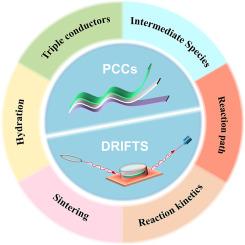A comprehensive review of diffuse reflectance infrared Fourier transform spectroscopy (DRIFTS) techniques in protonic ceramic cells (PCCs): Current status and future perspective
IF 36.6
Q1 ELECTROCHEMISTRY
引用次数: 0
Abstract
Protonic ceramic cells (PCCs) have emerged as a promising technology for power generation, energy storage, and value-added chemical synthesis, offering benefits such as fuel flexibility, low emissions, and efficient operation at intermediate temperatures (300–600 °C). Recently, significant breakthroughs in materials and manufacturing methods have markedly enhanced the performance of PCCs. However, establishing a fundamental understanding of their electrocatalytic reactions has gained less attention. As a fast and cost-effective method for physicochemical fingerprinting, diffuse reflectance infrared Fourier transform spectroscopy (DRIFTS) has proven to be a surface-sensitive analytical tool for structural and functional studies. This review critically examines the most up-to-date applications of DRIFTS for characterizing key components of PCCs, including oxygen electrodes, protonic electrolytes, and hydrogen electrodes for different applications, with a focus on revealing hydration properties and catalytic reactions, and guiding rational material design. The challenges for advancing DRIFTS, including quantitative capabilities and operando applications for PCC investigations, are highlighted and strategies to tackle these challenges are discussed. Ultimately, this review underscores the critical role of DRIFTS in accelerating the development of high-performance and durable PCCs for next-generation energy solutions, offering methodologies and insights broadly applicable to a wide range of electrochemical energy conversion and storage technologies.

质子陶瓷电池(PCCs)漫反射红外傅里叶变换光谱(DRIFTS)技术综述:现状与展望
质子陶瓷电池(PCCs)已经成为一种很有前途的发电、储能和增值化学合成技术,具有燃料灵活性、低排放和在中温(300-600°C)下高效运行等优点。近年来,材料和制造方法的重大突破显著提高了PCCs的性能。然而,建立对其电催化反应的基本理解却很少受到关注。漫反射红外傅里叶变换光谱(DRIFTS)作为一种快速、经济的物理化学指纹识别方法,已被证明是一种用于结构和功能研究的表面敏感分析工具。这篇综述严格审查了drift在表征PCCs关键成分方面的最新应用,包括氧电极、质子电解质和不同应用的氢电极,重点是揭示水合性能和催化反应,并指导合理的材料设计。重点介绍了推进DRIFTS面临的挑战,包括定量能力和PCC调查的操作应用,并讨论了应对这些挑战的策略。最后,本综述强调了DRIFTS在加速下一代能源解决方案高性能耐用PCCs开发中的关键作用,提供了广泛适用于各种电化学能量转换和存储技术的方法和见解。
本文章由计算机程序翻译,如有差异,请以英文原文为准。
求助全文
约1分钟内获得全文
求助全文

 求助内容:
求助内容: 应助结果提醒方式:
应助结果提醒方式:


